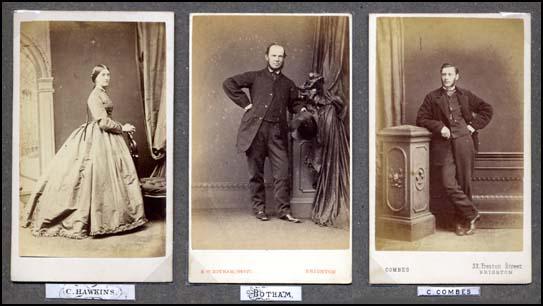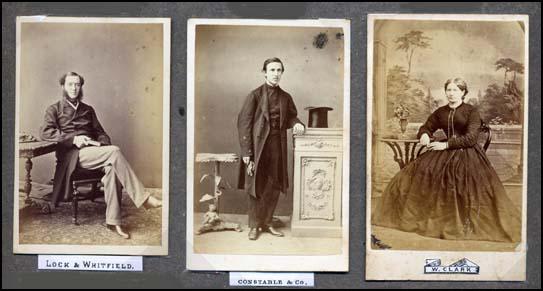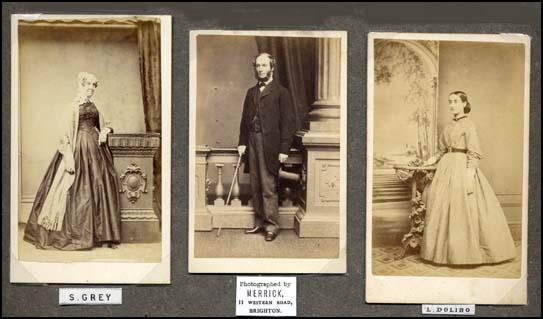Portraits for the Masses
A portrait made by either the daguerreotype or collodion positive
process was unique and copies could only be made by re-photographing
the original. Disderi's carte de visite method meant that one
negative whole-plate could hold up to eight individual images.
This eight picture negative could then be used repeatedly to produce
multiple copies. A photographer could therefore produce eight
small portraits at one sitting and from a single negative produce
a large number of prints, thereby greatly reducing the cost of
each portrait. When William Hall was in partnership with
Stephen Grey at 13 St James Street in 1854 a small daguerreotype
portrait could be had for 6 shillings ( 30 p.) In 1862, at the
same studio, William Hall was offering to provide a dozen
cdv portraits at a price of 12 shillings ( 60 p.). High class
photographic establishments such as Mayall's new portrait studio
at 90-91 King's Road Brighton, priced a set of twelve cdv portraits
at £1.1s (£1.05p) when the studio opened in July 1864.
Hennah & Kent, another quality portrait studio in Brighton,
"got 21/- a dozen for cartes" according to A.H.Fry,
who worked for the studio in the early 1860s. At the other end
of the scale, The West-End Photographic Company, based
at 109 Western Road Brighton was charging 5s (25 p.) for twelve
cartes de visite in 1864. At the same studio a single cdv portrait
would cost 1 shilling ( 5 p.), three copies could be had for 2
shillings (10 p.), while six copies could be purchased for 3s
(15 p.)

Carte de visite portraits
from Brighton photographic studios : HAWKINS; BOTHAM ;COMBES

Carte de visite portraits
from Brighton photographic studios::LOCK
& WHITFIELD; CONSTABLE; CLARK

Carte de visite portraits
from Brighton photographic studios::GREY;
MERRICK; DOLIBO:
In the 1860s, every High Street photographer in Brighton recognised
the fact that the carte de visite (cdv) was the most popular
of the portrait formats. The cdv also generated the most income.
It is reported that J J E Mayall produced over half a million
cartes a year, which helped him secure an annual income of £12,000.
In December 1861, The Photographic News declared "At
the present time, we believe cartes de visite are the most renumerative
class of portraits produced by professional photographers."
The Photographic News pointed out that the cdv's profitability
stemmed from the fact they were "generally ordered in
quanitities." The cdv itself became an advertisement
and generated business. As The Photographic News explained:
"each one sent out is a recommendation and almost certainly
brings fresh customers. Thus a sitter orders a dozen copies; in
giving these to his friends, he places each one, to a certain
extent under the obligation of giving a portrait in return; and
thus it happens that every portrait taken becomes, as it were,
the nucleus of a fresh order."